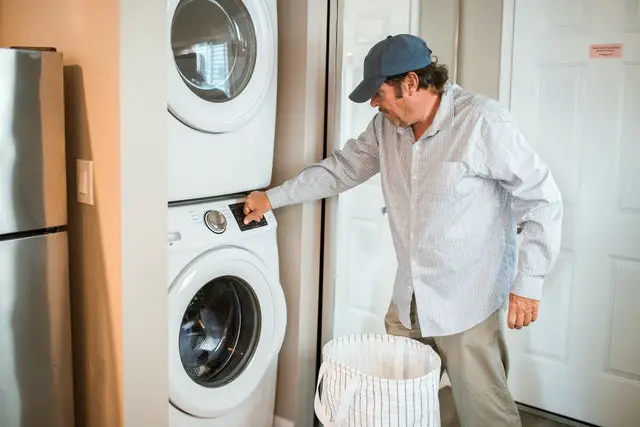As environmental awareness grows and the importance of preserving our ecosystems becomes increasingly evident, many homeowners are taking a closer look at the products they use daily.
One area of concern is the impact of household cleaning agents on septic systems.
A well-functioning septic system is crucial for maintaining a healthy and sustainable living environment, as it treats wastewater and safely returns it to the water cycle. In this article, we explore how Woolite measures up when it comes to septic system compatibility?
We’ll delve into the ingredients and formulation of Woolite, discuss the potential risks and benefits to septic systems, and provide insight on how to make informed choices for both your wardrobe and your wastewater treatment system.

What Is A Septic System, How Does It Work, And What Is The Importance Of Maintaining A Healthy Septic System?
A septic system is an on-site wastewater treatment and disposal system commonly used in rural areas and locations where centralized sewer systems are not available.
It serves as an efficient and environmentally-friendly method to manage household wastewater, including water from sinks, showers, toilets and washing machines.
A septic system typically consists of two main components: the septic tank and the drain field.
The septic tank is a buried, watertight container, usually made of concrete, fiberglass or polyethylene.
Wastewater from the house flows into the tank, where solids and liquids separate.
The solids settle at the bottom, forming a layer of sludge, while lighter materials like fats, oils and grease float to the top, forming a scum layer.
Anaerobic bacteria break down the solids thereby reducing their volume.
The clarified liquid, called effluent, flows out of the tank and into the drain field: a series of perforated pipes buried in trenches filled with gravel or a similar material.
The effluent percolates through the gravel and into the soil, where natural processes, including filtration and microbial action, remove remaining contaminants, making it safe to re-enter the water cycle.
Maintaining a healthy septic system is crucial for several reasons, these include:
- Environmental protection: A well-functioning septic system effectively treats wastewater, preventing groundwater contamination and protecting nearby rivers, lakes and other water bodies from pollution.
- Public health: Proper wastewater treatment safeguards public health by reducing the risk of waterborne diseases caused by harmful bacteria, viruses and parasites.
- Financial savings: Regular maintenance and care can extend the life of a septic system, saving homeowners the expense of costly repairs or replacements.
- Property value: A well-maintained septic system can contribute to a higher property value and a more attractive home for potential buyers.
What Is The Impact Of Laundry Detergent On Septic Systems
Laundry detergents can have varying impacts on septic systems depending on their ingredients, concentrations and the volume of detergent used.
Some components in laundry detergents can affect the bacterial balance, soil absorption and overall performance of a septic system.
Here are some of the ways laundry detergents can impact septic systems:
- Bacterial balance: Septic systems rely on the natural balance of bacteria to break down organic matter and solids. Some laundry detergents contain harsh chemicals, like bleach or antimicrobial agents that can kill beneficial bacteria in the septic tank. Reduced bacterial activity can result in an accumulation of solids, potentially causing blockages, system failure or the need for more frequent pumping.
- Surfactants: These are active cleaning agents found in most laundry detergents that help to remove dirt, grease and stains from fabrics. However, some surfactants, such as alkylbenzene sulfonates (ABS) and nonylphenol ethoxylates (NPE), are slow to biodegrade and can accumulate in the environment, posing a threat to aquatic life. Preferably, choose detergents with biodegradable surfactants like linear alkylbenzene sulfonates (LAS) or alcohol ethoxylates (AE) to minimize environmental impact.
- Phosphates: Many laundry detergents contain phosphates, which enhance cleaning performance by softening water and preventing dirt from redepositing on fabrics. While phosphates are generally harmless to the septic system, they can leach into groundwater, rivers and lakes, causing excessive algae growth, depletion of oxygen and harm to aquatic life. To minimize environmental risks, opt for phosphate-free laundry detergents.
- High-sudsing detergents: Excessive foaming and suds can cause problems in septic systems, as they may carry solids out of the tank and into the drain field, leading to clogging and reduced efficiency. Low-sudsing detergents are a better choice for septic systems.
- Volume of detergent: Using excessive amounts of detergent can overwhelm a septic system and disrupt its normal functioning. Follow the recommended dosage on the detergent packaging and consider using high-efficiency (HE) detergents, which are specifically designed for use in low-water settings and require less detergent per load.
Is Woolite Septic Safe?
Based on the factors discussed above, Woolite can be considered relatively septic-safe.
Woolite is known for its gentle formulation designed for delicate fabrics, and its mild nature suggests a lower likelihood of disrupting the bacterial balance in septic systems.
Here are a few of the reasons why Woolite is generally considered safe for septic systems:
Mild formula
Woolite is formulated to be gentle on fabrics, which usually implies the use of milder surfactants and bleach-free cleaning agents.
These ingredients are less likely to harm the beneficial bacteria in the septic tank, thus maintaining the proper functioning of the system.
Low-sudsing
Woolite is a low-sudsing detergent, which means it produces fewer suds and foam compared to other detergents.
As mentioned earlier, excessive foaming can lead to solids being carried into the drain field, causing clogs and reducing efficiency.
Low-sudsing detergents like Woolite are less likely to cause such issues.
Phosphate-free
Woolite is a phosphate-free detergent.
While phosphates generally do not pose a direct threat to septic systems, their absence in the detergent contributes to a more environmentally friendly product, reducing the risk of groundwater contamination and harm to aquatic life.
It is essential to note that Woolite has multiple product lines, and their formulations may vary.
To ensure septic safety, always check the label and ingredient list for any specific product.
In general, though, Woolite’s mild nature and low-sudsing properties make it a safer option for use in households with septic systems.
However, it is still crucial to use the detergent according to the recommended dosage and avoid combining it with other harsh chemicals that could disrupt the septic system’s balance.
List Of Septic Safe Laundry Detergents
Here is a list of septic-safe laundry detergents that are environmentally friendly and designed to work well with septic systems:
- ECOS Liquid Laundry Detergent with Built-In Fabric Softener – This hypoallergenic and plant-based detergent is formulated with biodegradable surfactants and a built-in fabric softener. It’s free of phosphates, dyes, and parabens, making it an excellent choice for septic systems.
- Seventh Generation Free & Clear Concentrated Laundry Detergent – This eco-friendly detergent is made from plant-based ingredients, is free of dyes, fragrances, and artificial brighteners, and is EPA Safer Choice certified. It’s a concentrated formula, which means you’ll use less detergent per load, further reducing its impact on septic systems.
- Method Free + Clear Laundry Detergent – This biodegradable, hypoallergenic detergent is formulated with plant-based cleaning agents and is free of dyes and fragrances. Its concentrated formula allows for less detergent usage, making it a septic-safe option.
- Charlie’s Soap Fragrance Free Laundry Powder – This non-toxic, biodegradable laundry powder is made from natural mineral ingredients and is free of dyes, fragrances, and phosphates. It’s also hypoallergenic and safe for septic systems.
- Arm & Hammer Plus OxiClean Odor Blasters Laundry Detergent – This detergent combines the cleaning power of Arm & Hammer baking soda with OxiClean stain fighters. It’s formulated to be septic-safe and is free of phosphates.
When looking for a septic-safe laundry detergent, consider the following signs
- Biodegradable surfactants: Opt for detergents containing biodegradable surfactants like linear alkylbenzene sulfonates (LAS) or alcohol ethoxylates (AE) that break down easily in the environment.
- Phosphate-free: Choose detergents that are free of phosphates to minimize the risk of groundwater contamination and harm to aquatic life.
- Low-sudsing: Low-sudsing detergents produce fewer suds and foam, reducing the risk of solids being carried into the drain field and causing clogs.
- Free of harsh chemicals: Avoid detergents with high concentrations of bleach, antimicrobial agents, or other harsh chemicals that can disrupt the bacterial balance in your septic system.
- Plant-based or natural ingredients: Detergents made with plant-based or natural ingredients are generally milder and less likely to harm the beneficial bacteria in your septic system.
- Hypoallergenic and fragrance-free: These detergents typically contain fewer irritants and chemicals, making them a safer choice for septic systems.
What Are Worst Laundry Detergents For Septic Systems?
Some laundry detergents can be particularly harmful to septic systems due to their composition or specific ingredients.
Here are a few characteristics of the worst laundry detergents for septic systems:
- High in phosphates
- Detergents with high concentrations of bleach, antimicrobial agents or other harsh chemicals that can disrupt the bacterial balance within the septic tank.
- Non-biodegradable surfactants
- High-sudsing
- Powdered detergents with fillers


